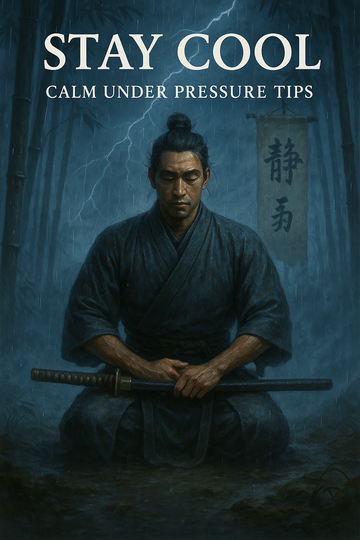Stay Cool: Calm Under Pressure Tips
Pressure has a way of distorting reality, affecting mental health with rising anxiety as heart rates spike, palms sweat, and thoughts begin to swirl at a breakneck pace. Whether delivering a big presentation, encountering urgent deadlines, or facing personal conflicts, these moments test more than knowledge, skill, or the handling of emotions. The way one responds with focus defines both immediate success and long-term resilience.
Calmness isn’t innate for most people; it’s a developed capacity. High-pressure moments can trigger ancient survival systems in the brain that urge us to fight, flee, or freeze. While this has evolutionary advantages, it rarely helps in boardrooms, hospitals, classrooms, or even at the dinner table. Developing composure and control, especially when everything’s on the line, is an art as well as a science.
Recognizing the Triggers
Awareness, rooted in mindfulness, is the first step. Too often, people react automatically to stress and anxiety, missing the subtle cues that foreshadow burnout and feeling overwhelmed.
Common physical cues:
- Faster heartbeat
- Shallow breathing
- Clenched jaw or fists
- Feeling distracted and losing focus
Common mental cues:
- Racing thoughts
- Catastrophizing outcomes
- Difficulty recalling information
- Self-doubt or negative internal chatter
Acknowledge these signals quickly; the swifter the recognition, the more agency there is to intervene.
The Science of Stress Reactivity
Under stress, cortisol and adrenaline flood the system, priming the body to react. The prefrontal cortex — responsible for planning and rational thought — becomes less active, while the amygdala, the brain's threat detector, takes charge. This hijacking can yield snap decisions and hasty words.
The most successful individuals in high-stakes arenas don’t necessarily feel less stressed, but they respond to it differently. They train their bodies and minds to notice what’s happening and use precise, learned strategies.
Practical Techniques for Staying Calm
Bringing physiological arousal under control is possible by mastering a handful of evidence-based practices. Consider these as tools in an internal toolkit:
Controlled Breathing
Controlled, deep breaths trigger the body’s relaxation response, enhancing mental clarity.
Try this simple method:
- Inhale slowly for 4 seconds
- Hold for 4 seconds
- Exhale gently for 8 seconds
Repeat a few times. Blood pressure drops, muscles relax, and clear thought returns.
Cognitive Reappraisal
How one interprets an event shapes the emotional experience. Reframing stress as a challenge rather than a threat shifts perspective and physiology.
Steps for reappraisal:
- Identify the specific thought (“I’m going to fail.”)
- Challenge its accuracy (“What evidence supports this? What evidence contradicts it?”)
- Replace with a balanced thought (“I’ve handled tough situations before.”)
Grounding Techniques
Practicing mindfulness by staying in the present moment is a key aspect of stress management and helps interrupt the runaway train of stress.
A quick exercise: Name three things you see, touch, and hear right now. This grounds attention and helps focus, reducing the grip of anxiety and anxious thoughts.
Visualization and Mental Practice
Elite athletes frequently use visualization and coping strategies to learn how to stay calm under pressure. Picture yourself succeeding under pressure. Focus on walking through the sights, sounds, and feelings in detail. This primes the brain to respond with more composure when the stakes are real.
Physical Movement
Sometimes the fastest way to reset is through movement. Stretching, pacing, or a brisk walk can use up stress hormones.
The Power of Preparation
Few things fuel calmness like good preparation. Knowing the material, practicing expected scenarios, or visualizing the process can make even intimidating situations feel more manageable.
Plan in advance for possible obstacles. Make checklists. Develop a step-by-step routine for predictable high-pressure moments, whether it’s meetings, interviews, or performances.
Communication Strategies
Pressure often rises in group settings: job interviews, team sports, crisis calls, or negotiations. Calm communication can reduce overall tension for everyone involved.
Key approaches include:
- Pausing before responding
- Speaking slowly and clearly
- Summarizing what was heard before answering
- Keeping the tone neutral and open
Remember, calm is contagious.
Building Stress Resilience Over Time
Short-term tricks help in the moment, but cumulative habits make the biggest difference. Integrate these practices to raise your baseline of calmness:
|
Habit |
Benefit |
|---|---|
|
Regular exercise |
Lowers baseline anxiety and increases mood stability |
|
Mindfulness/meditation |
Trains attention and reduces overall reactivity |
|
Adequate sleep |
Supports clear thinking and emotional regulation |
|
Healthy eating |
Balances energy and cognitive performance |
|
Social support |
Provides perspective and emotional buffering |
Consistency with these routines strengthens the mind and body against stress, enhancing emotional resilience and mental health, making unexpected challenges feel less daunting.
Harnessing Positive Thinking
Staying calm under pressure often begins with the mindset you bring to challenging situations. Positive thinking is not about ignoring difficulties or pretending everything is perfect; it’s about approaching obstacles with a constructive and optimistic outlook. When you consciously choose to focus on solutions rather than problems, you empower yourself to respond rather than react.
Start by reframing negative thoughts. Instead of dwelling on what could go wrong, ask yourself what you can learn or how you might grow from the experience. Practice gratitude by acknowledging small wins and positive moments, even in stressful times. This shift in perspective can reduce anxiety and boost your resilience.
Visualization is another powerful tool. Picture yourself handling pressure with confidence and composure. This mental rehearsal prepares your mind for success and helps you remain steady when real challenges arise.
Surround yourself with positive influences—people, books, or environments that uplift and inspire you. Their optimism can be contagious, reinforcing your own ability to stay calm and focused.
By harnessing positive thinking, you transform pressure into an opportunity for growth, allowing you to navigate stress with clarity and confidence.
Learning From High-Pressure Professions
Consider the techniques used by emergency responders, pilots, surgeons, or stage performers:
- Checklists: Minimize cognitive load during urgent scenarios
- Simulation training: Prepare for rare but critical situations
- Debriefings: Identify what worked and what to adjust for next time
Borrowing these strategies builds confidence and poise, even if your “emergency” is a tough meeting instead of a medical procedure.
The Role of Self-Talk
Attention quickly turns inward during stress, with a focus on a running commentary that can help or hinder.
Shifting internal dialogue from defeat (“I’ll never get through this”) to support (“I’m feeling nervous, experiencing anxiety, and I can handle this”) acknowledges emotions while maintaining motivation and perspective, a practice rooted in mindfulness. Practicing compassionate self-talk, especially during setbacks or mistakes, protects long-term confidence and well-being.
Harnessing Positive Thinking
Staying calm under pressure often begins with the mindset you bring to challenging situations. Positive thinking is not about ignoring difficulties or pretending everything is perfect; it’s about approaching obstacles with a constructive and optimistic outlook. When you consciously choose to focus on solutions rather than problems, you empower yourself to respond rather than react.
Start by reframing negative thoughts. Instead of dwelling on what could go wrong, ask yourself what you can learn or how you might grow from the experience. Practice gratitude by acknowledging small wins and positive moments, even in stressful times. This shift in perspective can reduce anxiety and boost your resilience.
Visualization is another powerful tool. Picture yourself handling pressure with confidence and composure. This mental rehearsal prepares your mind for success and helps you remain steady when real challenges arise.
Surround yourself with positive influences—people, books, or environments that uplift and inspire you. Their optimism can be contagious, reinforcing your own ability to stay calm and focused.
By harnessing positive thinking, you transform pressure into an opportunity for growth, allowing you to navigate stress with clarity and confidence.
Mistakes and Failure: Processing, Learning, and Moving On
Pressure often produces missteps. It’s only human. Training yourself to respond to mistakes with curiosity rather than self-criticism requires practice but leads to faster recovery. Debrief with a trusted colleague, coach, or even through journaling.
- What actually happened?
- Which factors were within my control, and which were not?
- What, specifically, can I try differently next time?
This cycle of reflection and adaptation turns stressful situations into opportunities for personal growth.
Leading Others Through Stress
If you find yourself responsible for a group under pressure, your demeanor sets the emotional tone. Leaders who remain calm during uncertainty foster trust and stability.
Ways to support others:
- Model deep breathing or gathering thoughts before responding
- Set clear expectations and allow for questions
- Recognize progress, not just outcomes
Teams with calm leaders report higher job satisfaction and are more effective at solving tough problems.
When Calm Feels Out of Reach
Sometimes, stress feels overwhelming despite all your best efforts. In these moments, seeking outside help is an act of strength, not weakness. Speak with a mentor, therapist, or medical professional when stress impairs daily functioning.
For rare but high-stakes events, consider professional coaching or counseling to build targeted skills or recover from emotional setbacks.
How to Train Yourself to Be Calm Under Pressure
Training yourself to remain calm under pressure is a skill that can be developed with intentional practice and patience. Here are some effective strategies to help you build this vital ability:
1. Practice Mindful Breathing: When stress hits, your body’s natural response is often rapid, shallow breathing. Counteract this by practicing slow, deep breaths. Inhale deeply through your nose, hold for a few seconds, and exhale slowly. This simple technique signals your brain to relax and helps you regain control in tense moments.
2. Embrace Regular Mindfulness or Meditation: Daily mindfulness exercises or meditation can rewire your brain to handle stress more effectively. Even a few minutes each day can increase your awareness of your thoughts and emotions, making it easier to stay grounded when pressure mounts.
3. Simulate Stressful Situations: Expose yourself to controlled, challenging scenarios—such as public speaking, timed tasks, or competitive games. By practicing in these environments, you train your mind and body to respond calmly when real-life pressure arises.
4. Develop Healthy Routines: A strong foundation of sleep, nutrition, and exercise equips your body to handle stress. When you’re physically well, you’re more likely to remain composed during difficult times.
5. Reflect and Learn: After facing a stressful situation, take time to reflect. What worked? What could you improve next time? This self-awareness helps you refine your approach and build confidence in your ability to stay calm.
6. Use Positive Self-Talk: Replace self-doubt with encouraging affirmations. Remind yourself of past successes and your ability to handle challenges. Positive self-talk can shift your mindset and reduce anxiety in high-pressure moments.
By consistently applying these techniques, you can train yourself to remain calm, focused, and effective—even when the pressure is on. Over time, staying composed becomes second nature, empowering you to thrive in any situation.
Cultivating Calm as a Core Value
Composure is more than a tactic for enduring difficult moments; it's an approach that permeates habits, relationships, and professional choices. When calm becomes one of your core values, pressure no longer feels like the enemy. It becomes a proving ground for resilience, creativity, and effective communication.
Pressure will always exist. But so can a robust sense of calm, ready to meet it—and outlast it—every time.





